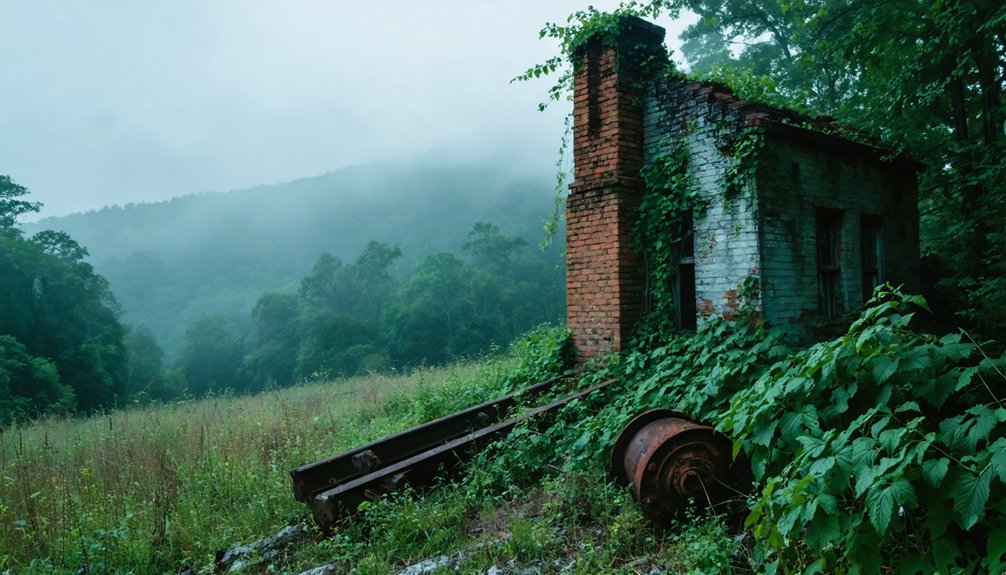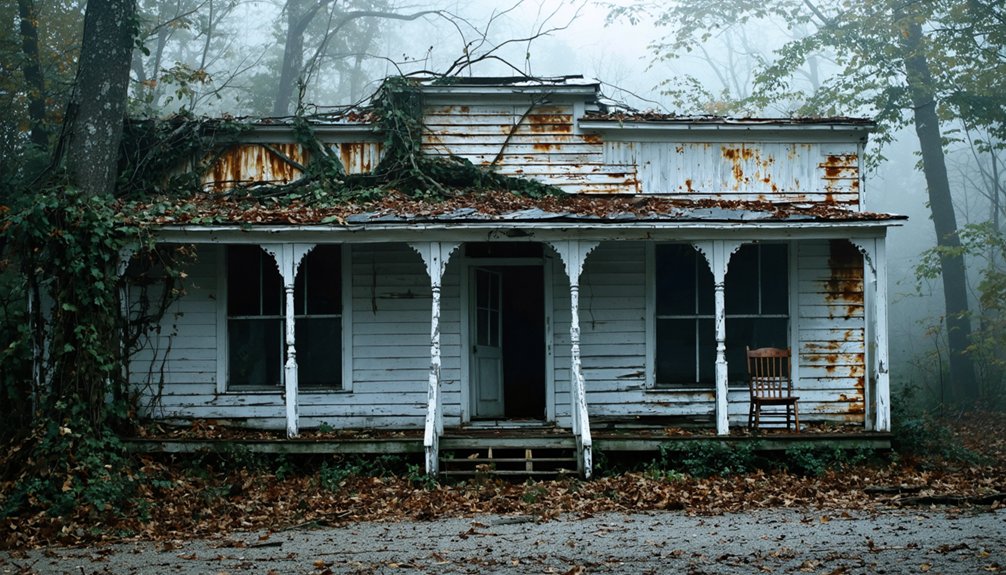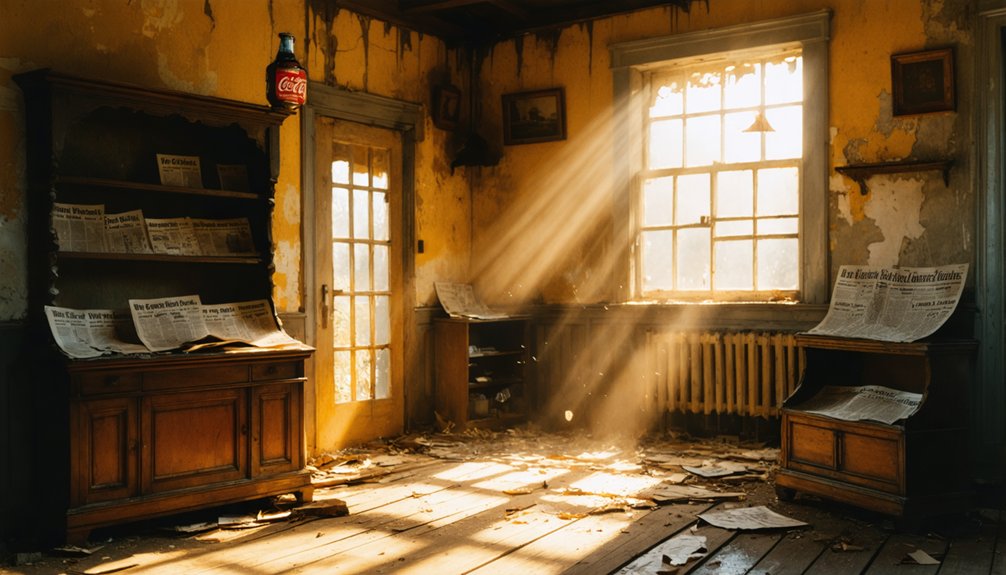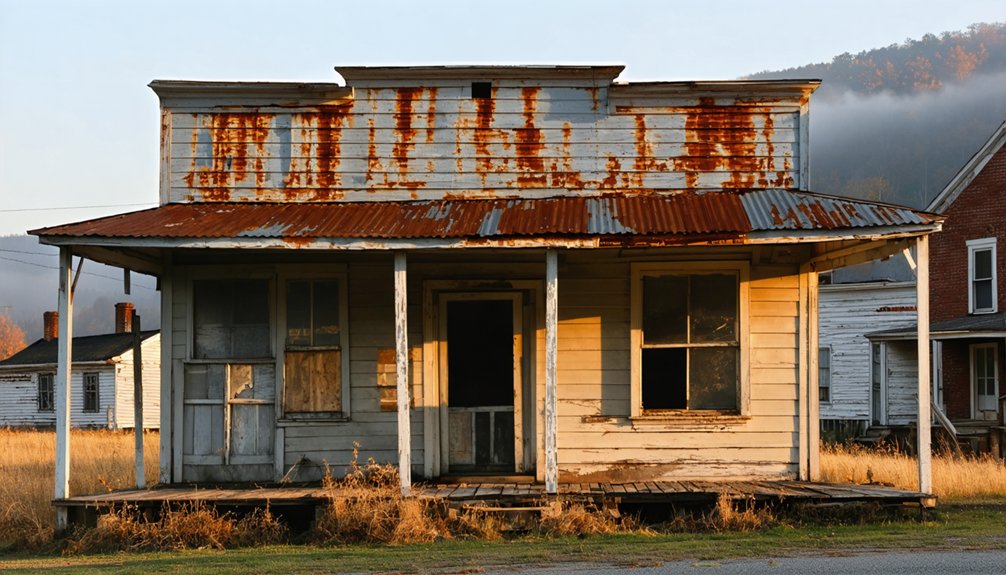You’ll find Hell For Certain, Kentucky, about 10 miles northwest of Hyden in Leslie County’s Appalachian wilderness. Named after a missionary’s blunt assessment of the harsh living conditions, this former mining settlement began declining in the early 1900s. Today, you can spot scattered homesteads, the Victory Mountain Grace Brethren Chapel (built 1952), and the famous road sign marking this ghost town. The surrounding dense forests and rugged landscape hold countless stories of Appalachian grit and determination.
Key Takeaways
- Hell For Certain is a ghost town in Leslie County, Kentucky, named after a missionary’s comment about the harsh living conditions.
- The town declined after coal mining operations closed, causing mass exodus of residents and deterioration of essential services.
- Only scattered homesteads and the Victory Mountain Grace Brethren Chapel from 1952 remain as evidence of the former community.
- The area features dense Appalachian forests and Hell for Certain Creek, located about 10 miles northwest of Hyden.
- Despite its abandoned status, the town attracts visitors curious about its unusual name and local folklore.
The Peculiar Origins of a Memorable Name
The name stuck so firmly that it became the identifier for both the settlement and its creek, though you’ll sometimes see it spelled “Hell-Fer-Sartin” in the local Appalachian dialect.
Today, the area consists of a few scattered houses along the rural landscape.
Officially, the US Postal Service opted for the tamer “Dryhill” designation.
According to local legend, the community’s unforgettable name came from a missionary’s stark assessment of the remote mountain location.
Geographic Location and Natural Surroundings
Nestled in the heart of Leslie County, Kentucky, Hell for Certain lies about ten miles northwest of Hyden, where dense Appalachian forests blanket the rolling hills.
Deep within Leslie County’s wilderness, Hell for Certain emerges from Appalachia’s emerald slopes, a hidden realm cloaked by endless forest.
You’ll find this remote community along Hell for Certain Creek, a tributary of the Middle Fork of the Kentucky River, surrounded by terrain features that define the rugged Appalachian landscape.
The area’s climate conditions follow eastern Kentucky’s humid continental pattern, shaping the natural environment around you.
Like the mysterious overgrown gravel road of Elsewhere, Kentucky, untamed pathways wind through the dense forest.
The location is known on most maps as Dryhill, though locals continue to use its more colorful name.
Here’s what makes this location uniquely enchanting:
- Pristine forestland stretches as far as the eye can see, offering an escape from civilization
- Natural pathways wind along creeksides, leading to hidden valleys and overlooks
- Untamed wilderness surrounds you with the raw beauty of Kingdom Come State Park nearby
Life in an Appalachian Settlement
Life in Hell for Certain exemplified typical Appalachian settlement patterns, where families clustered in isolated “island communities” of two to twelve households along creek bottoms and hollows.
You’d find yourself engaged in subsistence farming, with corn as your primary crop, while hunting deer and fishing supplemented your family’s diet. The Scotch-Irish and Germans were among the first pioneers to establish these early farming communities. The women in your household would manage the farming and domestic duties, carrying forward matrilineal traditions, while the men handled political matters and defense. These settlers established self-sufficient communities in the mountains, focused on independence from larger governments.
Your daily routine would revolve around tight-knit family dynamics, where extended kin controlled local power structures.
You’d rely on small crossroads stores and mills for necessities you couldn’t produce, trading through barter systems. The settlement school would serve as your community center, offering education, healthcare, and a place to preserve local customs and crafts.
Local Legends and Cultural Impact
While many Kentucky towns earned their names from prominent settlers or natural features, Hell For Certain‘s moniker stems from a missionary’s exasperated comment about the area’s harsh conditions. The name has become deeply woven into local folklore, serving as a reflection of the region’s rugged character and the resilient spirit of its people.
Hell For Certain, Kentucky reminds us how a moment of frustration became an enduring symbol of Appalachian grit and determination.
You’ll find the town’s unique identity reflected in these cultural touchstones:
- The Weather Channel’s Halloween feature that brought national attention to this aptly-named settlement
- Local businesses that’ve embraced the name’s cultural humor, creating memorable souvenirs
- The stark contrast with nearby Kingdom Come State Park, known as “Heaven,” adding to the area’s mystique
The name continues to attract curious visitors, while preserving an important piece of Appalachian cultural heritage. Like many ghost towns that once thrived during the timber and coal boom, the area’s economic decline paralleled the depletion of its natural resources.
Remaining Structures and Landmarks
Despite its intriguing name, Hell For Certain exists today as little more than scattered homesteads and a memorable road sign along Hell For Certain Creek.
You’ll find no bustling downtown or historic district here – the remaining structures consist of just a few occupied houses and possibly a church, nestled among the forested hills of eastern Kentucky’s Appalachian terrain.
Unlike other Kentucky ghost towns that showcase abandoned mines or preserved company stores, Hell For Certain’s local architecture reflects its humble origins as a rural settlement. Like the restless spirits of Camp Taylor soldiers, some locals claim to see shadowy figures marching through the dense forest at night.
The area’s eerie atmosphere is enhanced by the fall foliage season that transforms the surrounding wilderness into a haunting display of colors.
You won’t discover any significant ruins or historic landmarks beyond the natural beauty of the creek and surrounding hollows.
The site, also known as Dryhill on some maps, maintains a small population but lacks the physical remnants typically associated with more prominent ghost towns.
Historical Challenges and Population Decline
You’ll find that Hell For Certain’s population decline began in earnest as coal mining operations shuttered throughout Leslie County, forcing many families to seek work elsewhere.
The town’s extreme isolation and lack of modern infrastructure made it nearly impossible for residents to establish alternative industries or maintain sustainable livelihoods.
Mining Exodus Effects
As coal mines across Kentucky shuttered their operations in the mid-20th century, Hell For Certain and surrounding mining towns experienced a devastating economic collapse that triggered mass exodus.
The impact of this economic migration transformed once-vibrant communities into shadows of their former selves, testing community resilience to its limits. Similar to how disambiguation aids help clarify multiple meanings and direct users to specific content, local historians worked to preserve distinct stories of each affected mining town.
You’d have witnessed:
- Hundreds of miners losing their jobs overnight when operations like Mine 18 at Blue Heron closed in 1962
- Families forced to abandon company-owned homes as coal companies withdrew their paternalistic control
- Essential services and infrastructure crumbling as population numbers dwindled
The harsh reality of dangerous working conditions, coupled with tragic disasters like the Hurricane Creek explosion of 1970, had already strained the community’s will to stay.
When the mines closed, taking with them both jobs and social infrastructure, exodus became inevitable.
Isolation Drives Departure
While Hell For Certain’s name sparked curiosity among outsiders, the harsh realities of geographic isolation ultimately drove its inhabitants away. You’d find yourself cut off from the modern world, with no electricity, running water, or reliable roads connecting you to neighboring communities.
The social detachment took its toll on families who struggled daily with primitive conditions. Without schools, stores, or medical facilities nearby, you’d face grueling trips just to meet basic needs.
The emotional strain of managing households in such remoteness, coupled with limited work beyond mining, pushed residents to seek opportunities elsewhere.
Despite residents’ love for the natural landscape, the combined hardships of isolation proved too challenging. One by one, families left their mountain homes behind, unable to sustain life in Kentucky’s most isolated community.
Modern-Day Visits and Legacy

Today’s visitors to Hell For Certain will find little more than a road sign and scattered houses in this remote Leslie County location, situated a few miles north of Hyden along the Middle Fork of the Kentucky River.
Your visitor experiences might include seeing the Victory Mountain Grace Brethren Chapel, dating back to 1952, which stands as one of the few remaining structures from the area’s more active past.
A solitary church from 1952 stands sentinel, preserving memories of busier times in this quiet mountain community.
The region’s cultural curiosity draws people for three distinct reasons:
- Its intriguing name, originating from a missionary’s frustrated description
- The ironic proximity to Kingdom Come State Park (known as “Heaven”)
- The rugged Appalachian beauty and rich mining heritage
Despite limited infrastructure, Hell For Certain’s legacy lives on through local folklore, family histories, and its enduring role in Kentucky’s cultural landscape.
Frequently Asked Questions
Are There Any Ghost Stories or Paranormal Activities Reported in Hell for Certain?
Ever wonder about Kentucky’s eeriest spots? You won’t find documented ghost sightings or haunted locations in Hell for Certain – despite its menacing name, there aren’t any confirmed paranormal activities in this remote area.
What’s the Nearest Major Airport to Hell for Certain, Kentucky?
When planning your travel options to the area, you’ll find Cincinnati/Northern Kentucky International Airport (CVG) is your nearest major airport, located in Hebron, Kentucky, offering extensive passenger and cargo services.
Was There Ever a Post Office or General Store Here?
You’ll find that post office history here is surprisingly murky, with records showing a disputed location in the 1950s-60s. No confirmed evidence exists of a permanent general store either.
Do Any Original Founding Families Still Live in the Area?
You’ll find it challenging to verify if any family descendants remain, as historical records are sparse. While some locals claim ancestral ties, there’s no documented proof of original founding families today.
Is Camping or Overnight Stays Allowed in Hell for Certain?
You can’t legally camp here due to Kentucky’s strict camping regulations. There aren’t any approved overnight accommodations, and you’ll risk fines and jail time for unauthorized outdoor sleeping.
References
- https://kyforky.com/blogs/journal/hell-for-certain-kentucky
- https://wbkr.com/heaven-hell-kentucky/
- https://www.youtube.com/watch?v=D9gOmfCuKLs
- https://thoughtcatalog.com/seamus-coffey/2015/08/theres-a-town-in-kentucky-that-you-wont-ever-be-able-to-find-on-a-map-and-for-good-reason/
- https://www.onlyinyourstate.com/state-pride/kentucky/hell-for-certain-ky
- https://omekas.lib.wvu.edu/home/s/historicizingheritage/item/2116
- https://wbkr.com/heaven-and-hell-in-kentucky/
- https://www.oklahoman.com/story/news/2009/10/28/ghost-town-in-kentucky-has-a-lively-history/61337332007/
- https://www.mentalfloss.com/article/56117/7-great-places-horrifying-names
- https://www.kyatlas.com/ky-hell-for-certain.html



